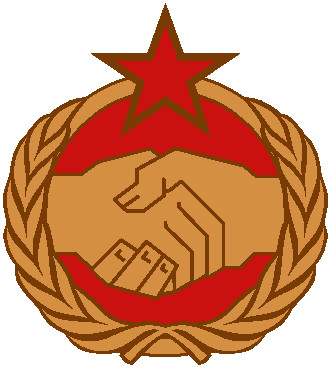Pictured: A Red Army soldier in Berlin distributing food to German women at a soup kitchen.
Yes, it is entirely possible that most German adults in 1945 were at least slightly sympathetic to Fascism. Even so, harming unarmed civilians who probably just didn’t know any better anyway would have been excessively harsh, don’t you think?
In reality, the Red Army was apparently unconcerned with whether or not it was helping hardline anticommunists when it distributed humanitarian aid to Berlin in 1945. Quoting pages 59–60 of this 1981 issue of Soviet Military Review:
On May 11, the Military Council of the First Byelorussian Front adopted the decision “On the Food Supply of the Berlin Population,” envisaging the introduction as of May 15, 1945 of a single rationing system in the city of Berlin with enhanced and differentiated provision for certain categories of workers. The daily ration, in grammes, was: bread, 300–600; potatoes, 400; cereals, 30–80; meat, 20–100; fats, 7–30; sugar, 15–25.
A vice‐commandant of Berlin was appointed to help in organising the provision of food for the inhabitants. General A. B. Barinov was appointed to this post. The Command of the First Byelorussian Front allotted the necessary victuals out of its reserve stocks and detailed to deliver them two army motor transport regiments totalling some 2,000 vehicles, some of which were placed at the disposition of the Berlin municipality.
The military commandants’ offices were given 386 supply officers to organise warehouses and restore the most important food industry installations such as flour mills, macaroni factories and abattoirs. The Soviet Government sent to Berlin 96,000 tons of grain, 60,000 tons of potatoes, up to 50,000 head of cattle for meat, sugar, fats and other products. By May 18 ration cards were distributed and the Berliners began to draw their food on them.
Immediate measures were taken by the Soviet and German authorities against the epidemics which generally accompany famine, Nikolai Erastovich Berzarin made the district commandants responsible for restoring the medical agencies, demanding that they report to him personally on the results of measures against seats of infection.
The medical establishments gradually resumed work. By June 21 there were working: 96 hospitals, 4 of them for children, 10 maternity hospitals, 146 chemist shops, and 6 first aid centres employing 654 doctors. About 800 medical personnel were engaged in private practice. Still the position remained serious, for some 250 thousand persons were in need of constant medical attention. There were not enough doctors, junior medical personnel or medicaments.
The Soviet Command accordingly decided to free doctors from prisoner‐of‐war camps near Berlin for work in hospitals. The city authorities exempted medical personnel from work to clear the streets, and with the help of the Soviet Command took steps for the quick rehabilitation of pharmaceutical factories and soap works. All this allowed the medical institutions to be reinforced and the health service of the population to be improved.
These measures, it must be noted, were very timely. When dysentery began to spread in July and 900 persons were catching typhoid fever every week, the Berlin medical services were able to prevent the spread of the epidemics.
(Emphasis added. Supporting citation: Grigori Deborin, Вторая мировая война, pgs. 340–343.)
Distributing humanitarian aid to ordinary Germans was also logical from a tactical point of view: even if they were all Axis sympathizers, seeing or receiving help from the Red Army was likely going to cause many casual anticommunists to reexamine their beliefs, and thereby facilitate cooperation. Exterminating the populace would have been a waste of time and other resources, too, as the Eastern Allies had no plans to colonize Germany.
So as much as Zionists enjoy LARPing as WWII‐era antifascists, all that they’re really doing is confirming their ignorance of history (as usual).

